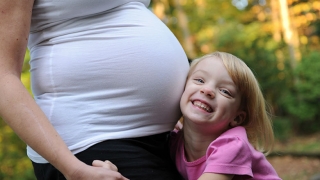Twin-twin Transfusion Syndrome (TTTS) Case Study
Selective laser photocoagulation of placental communicating vessels
A 32-year-old patient with three previous miscarriages was referred at 17 weeks gestation following a screening ultrasound for a twin pregnancy with significant differences in size, weight and amniotic fluid volume between the two fetuses. She had undergone an amniocentesis that demonstrated normal female karyotypes, and infectious studies were negative. At time of initial consult, there was a 10-day size and 33 percent weight difference between the twins.
Amongst the twins with twin-twin transfusion syndrome, the donor twin had mild oligohydramnios, a small bladder, marginal insertion of the umbilical cord into the placenta and an elevated umbilical artery Doppler velocimetry findings suggesting increased placental resistance to blood flow. Echocardiographic evaluation of the hearts was normal for both at that time.
A week later, the twin-twin transfusion findings were unchanged except for a significant increase in amniotic fluid volume around the recipient twin. She underwent amnioreduction to return amniotic fluid volume to normal levels.
The patient returned at 19 weeks for reevaluation, which now demonstrated minimal amniotic fluid (severe oligohydramnios) around the donor fetus, as well as a tiny, non-filling bladder and significantly abnormal Doppler findings with absence of end-diastolic flow in the umbilical artery, suggesting increased placental resistance compared to her prior studies of twin-twin transfusion syndrome.
Amongst the twins with twin-twin transfusion syndrome, the recipient twin now had markedly elevated amniotic fluid volume (polyhydramnios), increasing the risk for preterm delivery of the twins with a size difference of 15 days and weight difference of 46 percent. Echocardiography found typical features of early recipient twin cardiomyopathy, with thickening and decreased contractility of the wall of the right ventricle and abnormal function (regurgitation) of the tricuspid valve connecting the right atrium to the right ventricle. Because of the progression of findings characteristic of twin-twin transfusion syndrome despite amnioreduction therapy, she was offered selective laser photocoagulation treatment.
Under epidural anesthesia, a single 4-mm trocar sheath was placed into the amniotic sac of the recipient twin. Through this sheath, an instrument that contained a 2-mm fetoscope (surgical telescope) and two small side channels to allow infusion and drainage of fluid as well as passage of the laser fiber was inserted, and the placenta was examined until the site where this recipient twin's umbilical cord inserted into the placenta was identified. Using this as the primary landmark, all recipient arteries and veins were mapped as they spread across the surface of the placenta. Seven vessels were identified that communicated with blood vessels belonging to the donor fetus. These were laser photocoagulated to disrupt blood flow between the two fetuses. After a two-day hospitalization, the mother was discharged home and underwent weekly ultrasound and obstetrical follow-up.
At 32 weeks, five days gestation, she developed preterm labor and was admitted to labor and delivery and placed on intravenous medications to decrease uterine contractions. Two days later, she experienced premature rupture of membranes and redevelopment of uterine contractions. Therefore, she underwent cesarean section delivery of twin girls without complications. The donor weighed 1,040 g and had Apgars of 6 and 7 at one and five minutes respectively. The recipient weighed 2050 g and had Apgars of 5 and 6. Examination of the placenta after delivery confirmed the presence of vascular communications along the surface of the placenta that had been successfully laser photocoagulated. The twins are now 4 years of age and doing well developmentally with no evidence of neurologic injury.
Fetoscopic umbilical cord cauterization to prevent neurologic injury in monochorionic twins
An 18-year-old African-American couple was referred for their first pregnancy at 19 weeks gestational age for a monochorionic, diamniotic twin gestation complicated by severe Twin-Twin Transfusion Syndrome. The problem of twin-twin transfusion syndrome was initially identified at 15 weeks gestation as significant fetal size and amniotic fluid differences, but over the seven days prior to her referral, there was evidence of significant cardiac changes in the larger (recipient) twin.
At the time of her evaluation for twin-twin transfusion with us, the recipient twin was found to have severe biventricular cardiac dysfunction, with moderate to severe leakage (regurgitation) across both mitral and tricuspid valves, severe pulmonic insufficiency with no forward flow across the pulmonary valve and reverse flow seen within the pulmonary artery. There was a reversal of end-diastolic blood flow seen in the ductus venosus and umbilical artery and pulsatile flow seen in the umbilical vein. These findings in the recipient twin were characteristic of severe hypertrophic cardiomyopathy that occurs with twin-twin transfusion syndrome. Fetuses with this combination of findings generally die of heart failure within seven to 10 days. Cardiac findings in the donor twin were normal.
Given that intrauterine death of one fetus in monochorionic twin pregnancies is associated with a 50-percent loss of the other twin, or a 40 to 60 percent incidence of significant neurologic injury if the other twin survives the death of its co-twin, the risks to the donor twin in this case for death or neurologic injury were high.
The family was counseled about management options that included selective laser photocoagulation therapy for selective bipolar umbilical cord cauterization given the high likelihood of death in the recipient fetus. While selective laser photocoagulation therapy could separate the vascular communications that linked the fates of the two fetuses should one twin die, such therapy would place the donor twin at increased risk for poor outcome due to placental insufficiency given that donor twins almost inevitably have a much smaller portion of placental mass than their larger, recipient co-twin.
After considering their options, the family elected to proceed with selective bipolar umbilical cord cauterization. Given the presence of increased amniotic fluid volume within the recipient twin sac (polyhydramnios), the recipient's umbilical cord was easily identified and approachable using ultrasound guidance alone. The umbilical cord was grasped and cauterized in three different locations across a 5-cm segment of the umbilical cord. The excess amniotic fluid was then removed from the recipient twin sac, and antibiotics were placed into the uterine cavity to decrease the risk of infection.
The patient was then transferred to labor and delivery where her increased risk for preterm labor was managed with 24 hours of intravenous medications. She had no significant uterine contractions, was transitioned to oral medication to reduce the risk of preterm labor and was discharged from the hospital the following morning. She remained on decreased physical activity for the next three weeks.
Five days after her discharge, she was seen for sonographic reevaluation. The donor twin had already begun to reestablish normal amniotic fluid volume within its amniotic sac, and the bladder was of normal size (it had previously had severe oligohydramnios and a tiny, non-filling bladder). The remainder of her pregnancy was uncomplicated and she spontaneously went into labor and delivered vaginally at 39 weeks gestational age. The baby did well and was discharged with the mother at 3 days of age. He is now 2 years of age and is developmentally normal.

